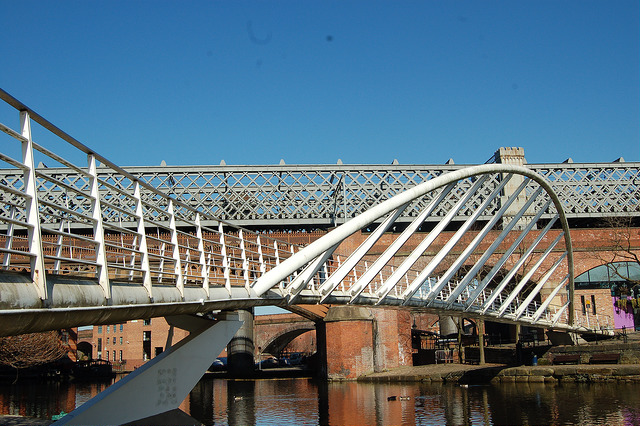A revolutionary canal in Manchester and the home of the modern co-operative movement in Rochdale are among ten places chosen today by Tristram Hunt, for Historic England’s campaign Irreplaceable: A History of England in 100 Places
The campaign aims to find the 100 places that bring to life England’s rich and extraordinary history.
Tristram Hunt, Director of the V&A has judged the Industry, Trade & Commerce category and is one of a panel of expert judges, including Baroness Tanni Grey-Thompson, Mary Beard, David Olusoga and Dr David Ison, Dean of St Paul’s Cathedral. Each judge has been tasked with choosing their top ten places in a range of different categories, from a long list of public nominations.
Historic England received 799 public nominations for the Industry, Trade & Commerce category- the highest received in any category.
Castlefield Canal Basin was the end point, the hub in Manchester, of the Bridgewater Canal.
Built between 1759 and 1761, it was the country’s first industrial arterial canal and was revolutionary because it used cuttings and tunnels to cross land without having to follow the course of a river. This short but important stretch was built so that the Duke of Bridgewater could have coal transported from his mines in Worsley to Manchester.
It was masterminded by the pioneering canal engineer, James Brindley whose innovative thinking overcame various challenges and laid the template for the canal network that developed across the country over the following 50 years. The coal transported to Manchester on canals like this powered the textile mills that transformed the city in the last quarter of the 18th century into a buzzing centre of industry.
Later, when the Bridgewater Canal was extended through to Liverpool it became the key course for moving cotton, food and other raw materials through to the ports at Liverpool, giving it a central role in the international trade that underpinned the Industrial Revolution. It is an astounding, if somewhat unassuming structure, which fundamentally changed the country.
Tristram Hunt said: “The transport revolution of the 18th century is part of the story of industrialisation. Canals were the motorways and the great trunk roads of the 18th century which helped quicken the pace of industrialisation in England.”
The Rochdale Society of Equitable Pioneers, or Rochdale Pioneers, were a group of 28 men, mostly weavers, who wanted to improve their quality of life. In 1844, at the height of difficult times in the working community, as the mechanisation of industry was forcing more and more workers into poverty, they opened a co-operative shop to sell a simple selection of high quality goods at honest prices.
The co-operative movement had begun earlier in the 19th century and like others that came before it, this co-operative was owned and run by its members. But importantly, the Pioneers ran it based on the “Rochdale Principles”.
These Principles stipulated that provisions should be of high quality and sold at full weight, that there should be equality of the sexes in membership and that the shop’s patrons should receive a dividend of the profits. These principles helped shape the way co-operatives around the world operate today and Toad Lane is widely regarded as the home of the modern worldwide co-operative movement.
This movement quickly grew. By the early 1900s there were over 1,600 co-operative societies and by the 1960s most UK towns had at least one. It was social enterprise in action and a chance for local people to have a say on their own quality of life, becoming equal members in a revolution that spread all over the world.
Tristram Hunt said: “Out of the Industrial Revolution came new ideas about the organisation of society and what the Rochdale Pioneers did was to bring a new model of sharing wealth to the world. On the one hand industrialisation was a celebration of capitalism but on the other hand ideas around socialism, communism and cooperation emerged which changed the country.”







